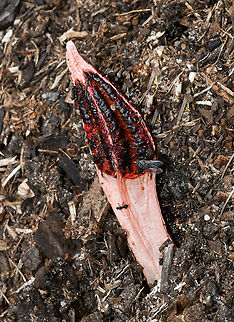
Appearance
Immature fruit bodies of "L. mokusin" are white, gelatinous "eggs" measuring 1–3 cm in diameter, and are attached to the ground by thickened strands of mycelium called rhizomorphs. As the fungus matures, the egg ruptures as the fruit body rapidly expands, leaving volval remnants behind at the base. The stipe of the hollow, spongy mature fruiting body has dimensions of 10–15 cm by 1.5–2.5 cm, and ranges in color from white to pink to red, with 4–6 distinct deeply grooved sides divided lengthwise by ribs. The basis of distinction between "L. mokusin" and other species of "Lysurus" is the angular form of its stipe. The sides branch out into 4–6 arms that are fused together at the tip to form a pointed apex, resembling a spire. As the mushroom matures, the arms may spread apart. The outer surface of the arms is coated by a brownish, slimy, foul-smelling spore mass called the gleba; its fetid odor helps it attract flies and other insects to assist in spore dispersal. The odor has been compared to "fresh dog feces", "rotting flesh" or sewage.The spores are cylindrical in shape, smooth, thin-walled, and hyaline, with dimensions of 4–6 by 2–2.5 μm. Scanning electron microscopy reveals that one end of the spores has a hilar scar—an indentation in the spore wall that results during its separation from the sterigma of the basidium. The basidia are usually eight-spored, and the gleba composed of chains of roughly spherical, fusiform, ellipsoid to broadly club-shaped cells that are either 6.5–7.4 by 2.8–5.6 μm or 37.1–46.3 by 18–28 μm and also mixed with filamentous cells 2.3–4.5 μm wide. The hyphae of "L. mokusin" have clamp connections.
Lysurus mokusin apex.jpg |alt=Close-up of fruit body tip, showing separation of the "arms" |Close-up of fruit body tip, showing separation of the "arms"
Lysurus mokusin broken.jpg |alt=Cross-sectional view of stipe |Cross-sectional view of stipe
Flies on Lysurus mokusin lantern stinkhorn fungus.jpg |alt=Flies attracted by the strong scent |Flies attracted by the strong scent
Naming
"Lysurus cruciatus" is similar is appearance to "L. mokusin", but has a cylindrical stem without any flutings at the tip. "Lysurus borealis" is also similar, but its stipe is not fluted, and without the angles present in "L. mokusin". "Lysurus periphragmoides" is cylindrical with a roundish lattice on top.Habitat
"Lysurus mokusin" is saprobic, and grows solitarily or in small groups in forest litter, and wood chip mulch used in landscaping, and compost. Documented sightings of "L. mokusin" include Australasia, the Canary Islands, Korea, Japan, China, and the Bonin Islands. The species was unknown in Europe until it was reported in Italy in 1979; it is considered an alien species in that continent. In the United States, it has been collected from the states of California, Texas, Northeast Oklahoma and Washington, D.C.Uses
This species is considered to be edible when still in the immature "egg" stage, and is thought to be a delicacy in China. When mature, its foul odor would deter most individuals from attempting consumption. The fungus has been used medicinally in China as a remedy for ulcers.References:
Some text fragments are auto parsed from Wikipedia.